HMS Sceptre was an R-class destroyer of the Royal Navy, built by Alexander Stephen and Sons, at Linthouse and launched on 18 April 1917. In total 51 ships were in this class and saw service in World War I, entering service from 1916 to 1917 and suffering comparatively light losses. Sceptre saw action as part of the Harwich Force, operating mainly in the North Sea. She survived the war and was sold for disposal in 1926.

HMS Ambuscade was an Acasta-class destroyer of the Royal Navy and was launched in 1913. She served throughout the First World War, forming part of the Grand Fleet and taking part at the Battle of Jutland, serving in the Dover Patrol and spending the latter part of the war as a convoy escort. She was sold for scrapping in 1921.

HMS Aurora was an Arethusa-class light cruiser that saw service in World War I with the Royal Navy. During the war, the cruiser participated in the Battle of Dogger Bank and was a member of the Grand Fleet when the main fleet of the Imperial German Navy surrendered to it in 1918. Following the war, Aurora was placed in reserve and in 1920, the cruiser was transferred to the Royal Canadian Navy. Her service with the Royal Canadian Navy was brief, being paid off in 1922. The cruiser was sold for scrap in 1927 and broken up.
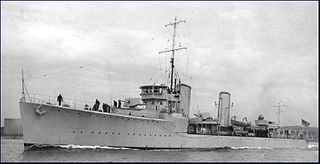
HMCS Champlain was a Thornycroft S-class destroyer, formerly HMS Torbay built for the Royal Navy in 1917–19. She was transferred to the Royal Canadian Navy in 1928 and served primarily as a training ship until 1936.

The Acasta class was a class of twenty destroyers built for the Royal Navy under the Naval Programme of 1911 - 1912 that saw service during World War I. They were the last class of Royal Navy destroyers to have mixed names with no systematic theme When the class was designated as "K", names beginning with that letter were allocated to the ships but never used. The class saw extensive wartime service and seven were lost, including four at the Battle of Jutland.

HMS Fortune was an Acasta-class destroyer, and the twenty-first ship of the Royal Navy to bear the name. She was launched in 1913 and was sunk at the Battle of Jutland in 1916.

HMS Tartar was a Tribal-class destroyer of the Royal Navy launched in 1907 and sold in 1921. During the First World War, she served in the North Sea and the English Channel with the 6th Destroyer Flotilla.
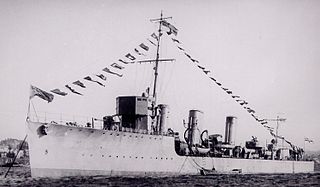
HMS Patriot was a Thornycroft M-class destroyer that served in the British Royal Navy. The destroyer entered service in 1915 during the First World War and saw service with the Grand Fleet. Following the war, the destroyer was declared surplus and in 1920, the ship was transferred to the Royal Canadian Navy. Recommissioned as HMCS Patriot, the destroyer was used primarily as a training ship. Patriot was taken out of service in 1927, sold for scrap in 1929 and broken up.

The Active-class cruisers were a trio of scout cruisers built for the Royal Navy shortly before the First World War. They were initially assigned to the First Fleet and became destroyer flotilla leaders in 1914. Amphion and Fearless and their flotillas were assigned to the Harwich Force when the war began in August 1914. They went out on a patrol on the first day of the war and Amphion and her destroyers encountered and sank a German minelayer. On the voyage home, the cruiser struck a mine laid by the German ship and sank. She was the first ship of the Royal Navy to be sunk in the war.

HMS Valkyrie was a First World War V-class flotilla leader of the Royal Navy. She was one of two destroyers ordered in July 1916 from William Denny & Bros. Ltd shipyard under the 9th Order for Destroyers of the Emergency War Program of 1916–17. She was originally to be called HMS Malcolm but was renamed before being completed. The name Malcolm was later assigned to another destroyer leader.
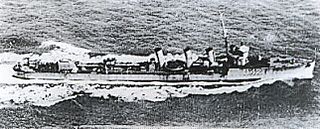
HMS Pasley was an Admiralty M-class destroyer built on the Tyne by Swan Hunter & Wigham Richardson for the Royal Navy and launched on 15 April 1916. She saw service during the First World War.
HMS Narborough was an Admiralty M-class destroyer built for the Royal Navy during the First World War. She was wrecked after running aground in 1918.

HMS Porpoise was an Acasta-class destroyer of the Royal Navy, which was built by Thornycroft between 1912 and 1914. Porpoise served through the First World War, taking part at the Battle of Jutland in 1916, where she was damaged. In 1920, she was sold to the Brazilian Navy serving under the name Alexandrino de Alencar and was renamed Maranhão in 1927. Maranhão remained in service when Brazil entered the Second World War, being used for patrol and convoy duties. She was disposed of in 1945.
HMS Negro was an Admiralty M-class destroyer of the Royal Navy. She was built by Palmers at Jarrow, Tyneside and launched 8 March 1916, but was sunk after colliding with HMS Hoste in the North Sea on 21 December 1916; depth charges from Hoste exploded and blew out Negro's hull plating. The ship was the second Royal Navy warship to bear the name Negro with the first being the 1813 Negro, ex-Niger.

HMS Rosalind was an R-class destroyer which served with the Royal Navy. The ship was launched by Thornycroft on 14 October 1916 as the first of five similar ships ordered from the yard. The design was used as the basis for five subsequent ships of the S-class also built by the company. Rosalind served as part of the Grand Fleet during the First World War, operating as an escort to other warships and in anti-submarine patrols alongside other destroyers. The vessel was sold to be broken up on 13 July 1926.

HMS Taurus was an R-class destroyer which served with the Royal Navy during World War I. Ordered from Thornycroft in 1915 and launched in 1917, the vessel operated as part of the Harwich Force until the end of hostilities. Shortly after entering service, Taurus formed part of the destroyer shield for the Royal Navy's bombardment of Ostend that successfully sank the German destroyer S20. After the War, the destroyer was reduced to the Reserve Fleet and sold to be broken up in 1930.

HMS Rob Roy was a Royal Navy R-class destroyer constructed and then operational in the First World War. The ship served in the Grand Fleet as part of the Fifteenth Destroyer Flotilla.
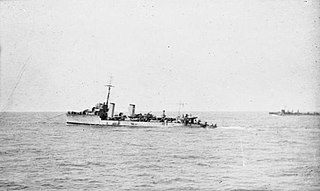
HMS Shakespeare was a Thornycroft type flotilla leader of the British Royal Navy. She was built by J I Thornycroft from 1916 to 1917 as the lead ship of her class, launching in July 1917 and completing in October 1917.
HMS Spenser was a Thornycroft type flotilla leader of the British Royal Navy. She was built by J I Thornycroft from 1916 to 1917 as the lead ship of her class, launching in September 1917 and completing in December that year.
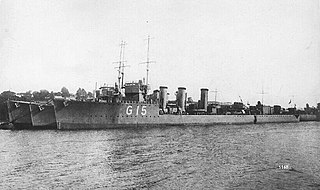
HMS Rigorous was an R-class destroyer which served with the Royal Navy during World War I. Launched on 30 September 1916, the vessel operated as part of the Grand Fleet, operating as part of destroyer flotillas hunting German ships that were attacking convoys. One flotilla was successful in destroying a Q ship in 1917. After the War, the destroyer was given a reduced complement and was sold to be broken up on 5 November 1926.















